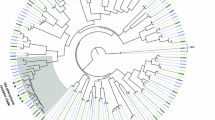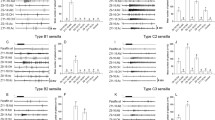Abstract
In biological systems, it is expected that gene expression levels generally will correlate with temporally varying physiological and biological needs, and that gene expression levels could regulate biological capabilities. In moth species, male response to female sex pheromones often is affected by moth age and mating status. Odorant receptors (ORs) expressed in neurons within male antennae are critical for detecting the female pheromones. Therefore, we hypothesized that the expression level of these receptor proteins would be affected by age and mating status of male moths. We examined expression levels of two OR genes that are preferentially expressed in the male antennae of Heliothis virescens (HvOR13 and HvOR15) and Heliothis subflexa (HsOR13 and HsOR15). Antennae were dissected from virgin males at 2 h, 1 d, 2 d, 4 d, and 8 d. We also dissected antennae from 4-d-old mated males. We found that age had no effect on expression levels of either OR in either species, except for a small difference in HsOR15 expression between 2 h and 8-d-old virgin males. Furthermore, we found no effect of mating status on expression level of these ORs in either species. We discuss these findings in relationship to studies of age and mating status effects on male electrophysiological and behavioral response to female pheromones, and contrast our results to studies on the effects of age and mating status on gene expression of pheromone receptor proteins and pheromone binding proteins in other moths.



Similar content being viewed by others
References
Abrantes, P., Dimopoulos, G., Grosso, A. R., Do Rosário, V. E., and Silveira, H. 2008. Chloroquine mediated modulation of Anopheles gambiae gene expression. PLoS ONE 3:e2587.
Abreu, R. D. S., Penalva, L. O., Marcotte, E .M., and Vogel, C. 2009. Global signatures of protein and mRNA expression levels. Mol. BioSyst. 5:1512–1526.
Anton, S., and Gadenne, C. 1999. Effect of juvenile hormone on the central nervous processing of sex pheromone in an insect. Proc. Natl. Acad. Sci. USA 96:5764–5767.
Bahrndorff, S., Marien, J., Loeschcke, V., and Ellers, J. 2009. Dynamics of heat-induced thermal stress resistance and Hsp70 expression in the springtail, Orchesella cincta. Funct. Ecol. 23:233–239.
Baker, T. C. 2009. Nearest neural neighbors: Moth sex pheromone receptors HR11 and HR13. Chem. Senses 34:465–468.
Baker, T. C., and Carde, R. T. 1979. Endogenous and exogenous factors affecting periodicities of female calling and male sex pheromone response in Grapholitha milesta (Busck). J. Insect Physiol. 25:943–950.
Burton, R. L. 1970. A low-cost artificial diet for corn earworm. J. Econ. Entomol. 63:1969–1970.
Chapin, J. B., Ganaway, D. R., Leonard, B. R., Micinski, S., Burris, E., and Graves, J. B. 1997. Species composition of heliothinae captured in cone traps baited with synthetic bollworm or tobacco budworm pheromones. Southwest. Entomol. 22:223–231.
Da Silva, E. F., De Carvalho, C. M., Do Nascimento, R. R., Mendonça, A. L., Da Silva, C. E., Gonçalves, G. B., Do Rosário, M., De Freitas, T., and Sant’ana, A. E. G. 2006. Reproductive behaviour of the Annona Fruit Borer, Cerconota anonella. Ethology 112:971–976.
Delisle, J. 1995. Effect of male and female age on the mating success of the obliquebanded leafroller Choristoneura rosaceana (Lepidoptera: Tortricidae) under different ecological conditions. J. Insect Behav. 8:781–799.
Delorme, J. D., and Payne, T. L. 1984. Effects of sensory adaptation, stimulus concentration and age on antennal olfactory response to sex-pheromone by male Heliothis zea. J. GA. Entomol. Soc. 19:371–377.
Dierick, H. A., and Greenspan, R. J. 2006. Molecular analysis of flies selected for aggressive behavior. Nat. Genet. 38:1023–1031.
Domingue, M. J., Roelofs, W. L., Linn, C. E., and Baker, T. C. 2006. Effects of egg-to-adult development time and adult age on olfactory neuron response to semiochemicals in European corn borers. J. Insect Physiol. 52:975–983.
Evenden, M. L., and Gries, R. 2008. Plasticity of male response to sex pheromone depends on physiological state in a long-lived moth. Anim. Behav. 75:663–672.
Fox, A. N., Pitts, R. J., Robertson, H. M., Carlson, J. R., and Zwiebel, L. J. 2001. Candidate odorant receptors from the malaria vector mosquito Anopheles gambiae and evidence of down-regulation in response to blood feeding. Proc. Natl. Acad. Sci. USA 98:14693–14697.
Gadenne, C., and Anton, S. 2000. Central processing of sex pheromone stimuli is differentially regulated by juvenile hormone in a male moth. J. Insect Physiol. 46:1195–1206.
Gadenne, C., Renou, M., and Sreng, L. 1993. Hormonal control of pheromone responsiveness in the male black cutworm Agrotis ipsilon. Experientia 49:721–724.
Gemeno, C., and Haynes, K. F. 2000. Periodical and age-related variation in chemical communication system of black cutworm moth Agrotis ipsilon. J. Chem. Ecol. 26:329–342.
Gohl, T., and Krieger, J. 2006. Immunolocalization of a candidate pheromone receptor in the antennae of the male moth, Heliothis virescens. Invert. Neurosci. 6:13–21.
Gould, F., Anderson, A., Reynolds, A., Bumgarner, L., and, Moar, W. 1995. Selection and genetic analysis of a Heliothis virescens (Lepidoptera, Noctuidae) strain with high levels of resistance to Bacillus thuringiensis toxins. J. Econ. Entomol. 88:1545–1559.
Gould, F., Estock, M., Hillier, N. K., Powell, R., Groot, A. T., Ward, C. M., Emerson, J., Schal, C., and Vickers, N. J. 2010. Sexual isolation of male moths explained by a single QTL containing four receptor genes. Proc. Nat. Acad. Sci. USA. 107:8660–8665.
Groot, A. T., Bennett, J., Hamilton, J., Santangelo, R. G., Schal, C., and Gould, F. 2006. Experimental evidence for interspecific directional selection on moth pheromone communication. Proc. Nat. Acad. Sci. USA. 103:5858–5863.
Groot, A. T., Estock, M. L., Horovitz, J. L., Hamilton, J., Santangelo, R. G., Schal, C., and Gould, F. 2009. QTL analysis of sex pheromone blend differences between two closely related moths: insights into divergence in biosynthetic pathways. Insect Biochem. Mol. Biol. 39:568–577.
Grosse-wilde, E., Gohl, T., Bouche, E., Breer, H., and Krieger, J. 2007. Candidate pheromone receptors provide the basis for the response of distinct antennal neurons to pheromonal compounds. Eur. J. Neurosci. 25:2364–2373.
Hansson, B. S. 1995. Olfaction in Lepidoptera. Experientia 51:1003–10027
Heath, R. R., Mclaughlin, J. R., Proshold, F., and Teal, P. E. A. 1991. Periodicity of female sex pheromone titer and release in Heliothis subflexa and Heliothis virescens (Lepidoptera: Noctuidae). Ann. Entomol. Soc. Am. 84:182–189.
Kanno, H., and Sato, A. 1978. Mating behavior of the rice stem borer moth, Chilo suppressalis Walker (Lepidoptera: Pyralidae) I. Effects of moth age on mating activity. Appl. Ent. Zool. 13:215–221.
Klepetka, B., and Gould, F. 1996. Effects of age and size on mating in Heliothis virescens (Lepidoptera: Noctuidae): implications for resistance management. Environ. Entomol. 25:993–1001.
Klun, J. A., Leonhardt, B. A., Lopez, J. D., and Lachance, L. E. 1982. Female Heliothis subflexa (Lepidoptera: Noctuidae) sex pheromone: chemistry and congeneric comparisons. Environ. Entomol. 11:1084–1090.
Krieger, J., Grosse-wilde, E., Gohl, T., Dewer, Y. M., Raming, K., and Breer, H. 2004. Genes encoding candidate pheromone receptors in a moth (Heliothis virescens). Proc. Natl. Acad. Sci. USA 101:11845–11850.
Krieger, J., Gondesen, I., Forstner, M., Gohl, T., Dewer, Y., and Breer, H. 2009. HR11 and HR13 receptor-expressing neurons are housed together in pheromone-responsive sensilla trichodea of male Heliothis virescens. Chem. Senses. 34:469–477.
Kurtovic, A., Widmer, A., and Dickson, B. J. 2007. A single class of olfactory neurons mediates behavioural responses to a Drosophila sex pheromone. Nature 446:542–546.
Merlin, C., Lucas, P., Rochat, D., François, M.-C., Maïbèche-coisne, M., and Jacquin-joly, E. 2007. An antennal circadian clock and circadiam rhythms in peripheral pheromone reception in the moth Spodoptera littoralis. J. Biol. Rhythms 22:502–514.
Michalak, P., Malone, J. H., Lee, I. T., Hoshino, D., and, Ma, D. 2007. Gene expression polymorphism in Drosophila populations. Molec. Ecol. 16:1179–1189.
Parajulee, M. N., Rummel, D. R., Arnold, M. D., and Carroll, S. C. 2004. Long-term seasonal abundance patterns of Helicoverpa zea and Heliothis virescens (Lepidoptera: Noctuidae) in the Texas high plains. J. Econ. Entomol. 97:668–677.
Patch, H. M., Velarde, R. A., Walden, K. K. O., and Robertson, H. M. 2009. A candidate pheromone and two odorant receptors of the Hawkmoth Manduca sexta. Chem. Senses 34:305–316.
Pearson, G. A., and Schal, C. 1999. Electroantennogram responses of both sexes of grape root borer (Lepidoptera: Sesiidae) to synthetic female sex pheromone. Environ. Entomol. 28: 943–946.
Peckol, E. L., Troemel, E. R., and Bargmann, C. I. 2001. Sensory experience and sensory activity regulate chemosensory receptor gene expression in Caenorhabditis elegans. Proc. Natl. Acad. Sci. USA 98:11032–11038.
Ramaswamy, S. B., Randle, S. A., and Ma, W. K. 1985. Field evaluation of the sex pheromone components of Heliothis virescens (Lepidoptera: Noctuidae) in cone traps. Environ. Entomol. 14:293–296.
Roelofs, W. L., Hill, A. S., Carde, R. T., and Baker, T. C. 1974. Two sex pheromone components of the tobacco budworm moth Heliothis virescens. Life Sci. 14:1555–1562.
Sas Institute Inc. (2004) SAS OnlineDoc® 9.1.3. Cary, NC: SAS Institute Inc.
Sheck, A. L., Groot, A. T., Ward, C. M., Gemeno, C., Wang, J., Brownie, C., Schal, C., and Gould, F. 2006. Genetics of sex pheromone blend differences between Heliothis virescens and Heliothis subflexa: a chromosome mapping approach. J. Evol. Biol. 19:600–617.
Shorey, H. H., Morin, K. L., and Gaston, L. K. 1968. Sex pheromones of Noctuid moths. XV. Timing of development of pheromone-responsiveness and other indicators of reproductive age in males of eight species. Ann. Entomol. Soc. Amer. 61:857–861.
Traynier, R. M. M. 1970. Sexual behaviour of the Mediterranean flour moth, Anagasta kühniella: Some influences of age, photoperiod, and light intensity. Can. Ent. 102:534–540.
Tumlinson, J. H., Hendricks, P. E., Mitchell, E. R., Doolittle, R. E., and Brennan, M. M. 1975. Isolation, identification, and synthesis of the sex pheromone of the tobacco budworm moth. J. Chem. Ecol. 1:203–214.
Vásquez, G. M., Fischer, P., Grozinger, C. M., and Gould F. in press. Differential expression of odorant receptor genes that are involved in sexual isolation of two Heliothis moths. Insect Mol. Biol.
Vetter, R. S., and Baker, T. C. 1983. Behavioral responses of male Heliothis virescens in a sustained flight tunnel to combinations of seven compounds identified from female sex pheromone glands. J. Chem. Ecol. 9:747–759.
Wang, G., Vásquez, G. M., Schal, C., Zwiebel, L. J., and Gould, F. in press. Functional characterization of pheromone receptors in the tobacco budworm Heliothis virescens. Insect Mol. Biol.
Xiu, W. M., and Dong, S. L. 2007. Molecular characterization of two pheromone binding proteins and quatitative analysis of their expression in the beet armyworm Spodoptera exigua Hübner. J Chem. Ecol. 33:947–961.
Zhang, Z.-C., Wang, M.-Q., and Zhang, G. 2009. Molecular cloning and expression of pheromone-binding protein1 from the diamondback moth, Plutella xylostella. Entomol. Exp. Appl. 133:136–145.
Zhou, S., Stone, E. A., Mackay, T. F., and Anholt, R. R. 2009. Plasticity of the chemoreceptor repertoire in Drosophila melanogaster. PLoS Genet 5:e1000681.
Acknowledgements
We thank Consuelo Arellano for statistical advice, and Rebekah Powell and Ollie Inglis for technical assistance. This work was funded by the USDA grant 2007-35607-17824 to F.G. and a W.M. Keck Post-doctoral Fellowship to G.M.V.
Author information
Authors and Affiliations
Corresponding author
Rights and permissions
About this article
Cite this article
Soques, S., Vásquez, G.M., Grozinger, C.M. et al. Age and Mating Status Do Not Affect Transcript Levels of Odorant Receptor Genes in Male Antennae of Heliothis virescens and Heliothis subflexa . J Chem Ecol 36, 1226–1233 (2010). https://doi.org/10.1007/s10886-010-9863-6
Received:
Revised:
Accepted:
Published:
Issue Date:
DOI: https://doi.org/10.1007/s10886-010-9863-6




